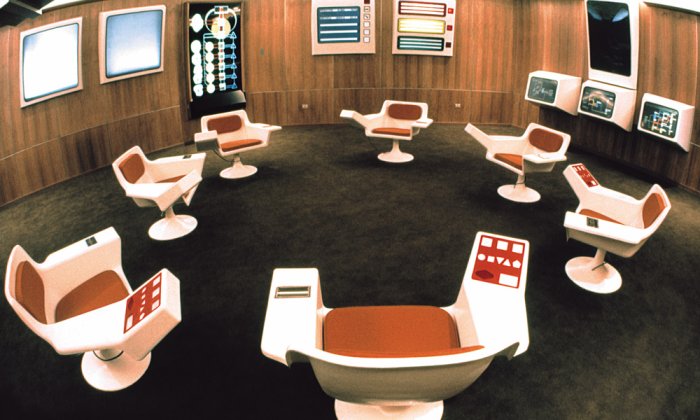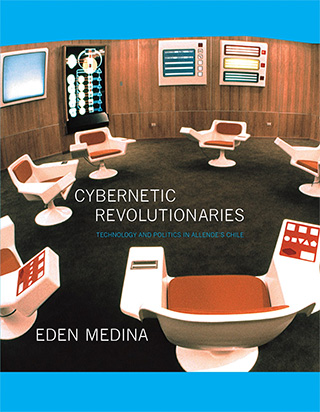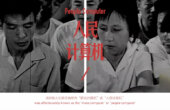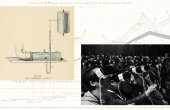Project Cybersyn: Chile's Radical Experiment in Cybernetic Socialism

On September 11, 1973, Chile’s first democratically elected Socialist president, Salvador Allende, delivered his final radio broadcast shortly after 9 a.m. By noon Hawker Hunter jet fighters were firing rockets at the presidential palace. By 2 p.m. Allende was dead. When the military violently ended Chile’s political experiment with socialism, it also ended the nation’s technological experiment with cybernetic management.

The story of Chile’s work to build an ambitious and pioneering technology, explored in the following excerpt adapted from Eden Medina’s 2011 book “Cybernetic Revolutionaries: Technology and Politics in Allende’s Chile,” sheds light on the complex ways that people have tried to use computer and communications technology to effect social, economic, and political change. By following how Chile’s innovative political experiment with democratic socialism led to the creation of this innovative technological system, we see that political innovation can spur technological innovation and that science, technology, and design were also distinguishing features of Chile’s socialist process. Different political contexts can open up new spaces of technological possibility. However, they can also foreclose them, regardless of the merits or shortcomings of the system under construction.
In 1970 Chilean voters opted to pursue a democratic road to socialist change under the guidance of Salvador Allende. As Chile’s first democratically elected Socialist president, Allende proposed a political third way, something different from the politics and ideology of either the United States or the Soviet Union during the Cold War.
Allende wanted to make Chile a socialist nation, but he also wanted change to occur peacefully and in a way that respected the nation’s existing democratic processes and institutions. Moving property ownership from foreign multinationals and the Chilean oligarchy to the state, redistributing income, and creating mechanisms for worker participation were among the top priorities of the Allende government. Among the democratic institutions that Allende wished to preserve were respect for election results, individual freedoms (such as the freedom of thought, speech, press, and assembly), and the rule of law. His commitment to socialist change through constitutional means set Chile’s socialism apart from that of Cuba or the Soviet Union. His platform became known as the “Chilean road to socialism.”
Chile was an exceptional nation within Latin America. From 1932 to 1973 Chile boasted the longest period of uninterrupted democratic rule in Latin America. Allende’s outward commitment to peaceful socialist change and the free expression of ideas stood in sharp contrast to the political situation in neighboring countries such as Argentina and Brazil. In 1970 these two nations had repressive military governments that had seized control, ostensibly to stop the threat of communism. Chile was also a battleground in the global cold war and a focus of U.S. attention. From 1962 to 1969 Chile received more than a billion dollars in U.S. aid, more than any other nation in Latin America, as part of the Alliance for Progress. The United States believed such levels of aid would help raise living standards for Chileans and thus stop members of the poor and working classes from turning to communism.
Members of the Chilean government thought that cybernetics might help the government gain control over the country’s economic transition.
The United States responded to Allende’s election by adopting a “non-overt course” to prevent Chile from turning socialist. This included funding government opposition parties and opposition-owned media outlets and sabotaging the Chilean economy. For example, the United States established an invisible financial blockade and significantly reduced its aid to Chile. It also used its substantial influence to cut international and bilateral aid and private bank credit to Chile, prevented Allende from renegotiating the national debt he had inherited from his predecessor, and decreased the value of U.S. exports to Chile. Allende’s commitment to changing Chile’s long-standing social and economic structures also met with strong opposition from members of Chile’s privileged classes. Nevertheless, Chile’s long and solid commitment to its democratic institutions led Chileans and onlookers from around the world to wonder whether Allende and his government might succeed in pioneering a new political model.
This political experiment set the stage for an innovative and ambitious technological experiment, known as Project Cybersyn. Bringing Chile’s most important industries under state control constituted a key plank in Allende’s political platform, and it soon challenged the management capabilities of the Allende government. Members of the Chilean government thought that electronic computers and the interdisciplinary science of cybernetics might help the government gain control over the country’s economic transition.
An Unexpected Invitation
In July 1971, the British cybernetician Stafford Beer received an unexpected letter from Chile. Its contents would dramatically change Beer’s life. The writer was a young Chilean engineer named Fernando Flores, who was working for the government of newly elected Socialist president Salvador Allende. Flores worked for the Chilean State Development Corporation, the agency responsible for leading the nationalization effort. Although Flores was only 28 when he wrote Beer, he held the third-highest position in the development agency and a leadership role in the Chilean nationalization process. Flores wrote that he was familiar with Beer’s work in management cybernetics and was “now in a position from which it is possible to implement on a national scale — at which cybernetic thinking becomes a necessity — scientific views on management and organization.” Flores asked Beer for advice on how to apply cybernetics to the management of the Chilean economy, which was expanding quickly because of Allende’s aggressive nationalization policy.
While it is impossible to give a universal definition of the interdisciplinary, postwar science known as “cybernetics,” the MIT mathematician Norbert Wiener, one of the originators of the field, offers one of the most cited. In 1948 he described cybernetics as the study of “control and communication in the animal and the machine.” Cybernetics often mixed metaphors from engineering and biology to describe the behavior of complex systems ranging from the electromechanical operation of a computer to the function of the human brain. It brought these, and other, fields together to help postulate the shared characteristics of machines and organisms in the areas of communication, feedback, and control so that these behaviors could be better understood. Some members of the cybernetics community viewed cybernetics as a universal language for the scientific study of machines, organisms, and organizations. Cybernetic thinking influenced subsequent work in information theory, computing, cognitive science, engineering, biology, social science, and industrial management.
Beer was a leading thinker in management cybernetics, which sought to apply cybernetic ideas to the management of a firm. From the 1950s onward, Beer had drawn from his understanding of the human nervous system to propose a form of management that allowed businesses to adapt quickly to a changing environment. A major theme in Beer’s writings was finding a balance between centralized and decentralized control, and how to ensure the stability of the entire firm without sacrificing the autonomy of its component parts. Many of these themes also defined Chile’s unique approach to peaceful, democratic socialism. For example, the Popular Unity (UP) government was confronting the challenge of how to implement substantial social, political, and economic changes without sacrificing Chile’s preexisting constitutional framework of democracy. Chile’s socialist process also required expanding the reach of the state without sacrificing the nation’s existing civil liberties and democratic institutions. Many of the core ideas that Beer expressed in his writings resonated with Flores.
“Believe me, I would surrender any of my retainer contracts I now have for the chance of working on this,” the British cybernetician Stafford Beer wrote.
Beer found the Chilean invitation irresistible. Flores was offering him a chance to apply his ideas on management on a national level and during a moment of political transformation. Beer decided he wanted to do more than simply offer advice, and his response to Flores was understandably enthusiastic. “Believe me, I would surrender any of my retainer contracts I now have for the chance of working on this,” Beer wrote. “That is because I believe your country is really going to do it.” Four months later, the cybernetician arrived in Chile to serve as a management consultant to the Chilean government.
The Battle of Production
Stafford Beer arrived in Chile on Tuesday, November 4, 1971, the first anniversary of the Allende government. On that same day the president addressed the Chilean people directly from the National Stadium in Santiago and detailed what his government had achieved during the preceding year. Among the most important of its accomplishments was the nationalization, intervention, or expropriation by the government of Chilean- and foreign-owned enterprises. Because of these significant strides, Allende now had a pressing need in his second year to find ways to manage the new and ever-growing public sector.
Structuralist economics and Keynesian “pump priming” had achieved economic growth through increased purchasing power and higher employment rates. By November 1971, workers in Chilean factories had realized a 30 percent average increase in real wages. As a result, a growing segment of the population had money to spend, thus stimulating the economy, increasing demand, raising production, and expanding the popular base of support for the UP coalition. In the Allende government’s first year, the gross domestic product grew by 7.7 percent, production increased by 13.7 percent, and consumption levels rose by 11.6 percent. By the end of 1971, the government had transferred all major mining firms and 68 of Chile’s most important industries from the private to the public sector. The speed of the changes must have impressed Beer, who often criticized governments for their sluggish bureaucracy and inability to implement change.
Chile was fighting a “battle of production,” meaning that it viewed raising industrial production levels as key to the success of Chilean socialism and aimed to do this by taking control of the “commanding heights” of the economy. Raising production levels would also help supply keep pace with the increases in demand caused by the redistribution of wealth and help control inflation. Allende’s key political goal was to bring about a socialist transformation using a democratic framework. However, he knew that the economy played a central role in this process; he could not make Chile socialist unless he could also make the economy thrive.
Building Cybersyn
Upon arriving in Santiago, Beer began work with a small Chilean team that Flores had assembled. The cybernetician learned about the management problems in growing nationalized sector and began mapping his cybernetics models onto the economic system to suggest solutions. He also drew up a proposal for “Project Cyberstride,” a “preliminary system of information and control for the industrial economy.” It offered the first concrete articulation of a computer system the government might build to address the problem of economic management. Beer noted that the system, if built, would “demonstrate the main features of cybernetic management” and “begin to help [the government] in the task of actual decision-making by March 1972” — four short months away.
Project Cyberstride incorporated ideas from Beer’s earlier writings and talks, including his idea for a “Liberty Machine.” This conceptual machine aimed to counteract the “immense inertia” by creating new networks for close to real-time information sharing to facilitate instant decision making and eschew bureaucratic protocols. Beer posited that such a Liberty Machine could create a government where “competent information is free to act,” meaning that once government officials become aware of a problem, they could address it quickly; expert knowledge, not bureaucratic politics, would guide policy. Beer envisioned that the physical Liberty Machine would consist of a series of operations rooms that received real-time information from the different systems being monitored and used computers to “distil the information content.” The Chile system would eventually include a control room that would be fed by data collected daily from state-controlled industries and would use mainframe technology to make statistical predictions about future economic behavior.
At the time, Chile’s National Computer Center (ECOM) owned four mainframe computers, all in high demand. The director of the National Computer Corporation (ECOM) offered Beer processing time on only one mainframe computer. As a solution to a seemingly impossible mandate, Beer offered a design for Project Cyberstride that consisted of a communications network attached to the single mainframe computer.
To make this nontraditional network architecture work, Beer and the team needed to find a way to inexpensively transmit numerical data and text in close to real time over long distances. The solution seemed to be the telex, or teletype, machines which were connected to an existing network of telephone lines, satellites, or microwave channels. Beer proposed that Project Cyberstride be built using a network of telex machines that the team could attach to the single mainframe. ENTEL, the National Telecommunications Enterprise, had 400 telex machines in storage that the previous government had purchased during the 1960s but never installed. With this find the team could begin to build the network Beer proposed without needing to import additional telex machines right away. That had been a major concern, given Chile’s dwindling foreign reserves and the invisible U.S.-led blockade.
In January 1972 Beer contacted the consulting firm Arthur Andersen and Company in London to see if they might be able to design the software for Project Cyberstride. However, Flores and Beer eventually decided to split the programming work between Chile and London to keep costs down while also moving the work forward at a rapid pace. The British team would focus on creating a temporary suite that would serve as a proof of concept, while the Chilean engineers would build a permanent suite that incorporated the parameters specific to the Chilean economy. The software used techniques in Bayesian statistical forecasting to recognize significant variations in production data and predict whether new data points signified the beginnings of a linear trend, an exponential trend, a step function, or an anomaly that would return to normal. In this way, the software was able to make predictions about economic behavior and revise its predictions on the fly.
Beer argued that the Cyberstride software would eventually permit the Chilean government to discard its traditional reporting methods — exhaustive printed reports of considerable length based on data collected monthly or yearly. Instead, it would allow the government to prioritize and channel its attention toward the industries in greatest need at any given time. Cyberstride instantiated a new type of socialist technology, one that did not try to put the government everywhere at once but instead helped it channel its limited resources where they were needed most. Beer also began forming a team to build an economic simulator. He intended the simulator to complement the Cyberstride software and act as “the government’s experimental laboratory.” Once complete, the simulator would allow government decision-makers to plan beyond day-to-day operations and experiment with different long-term economic policies.
Beer returned to Chile in March 1972. By then, the Chilean project team had expanded from 10 to 35 people. In mid-March, the computer agency, ECOM, transmitted the first results from the preliminary Cyberstride program developed by Arthur Anderson, simulating the daily practice that would take place once the Chilean-developed permanent suite was in place. However, the permanent suite still had a long way to go as it required Chilean operations research scientists to undertake studies of every nationalized enterprise and determine which production indicators the software should monitor; they also had to establish the acceptable range of values for these indicators. An initial version of the economic simulator was also in its beginning stages.
Cyberstride underwent a major change during Beer’s March visit. Most notably, the project acquired a new name: Project Cybersyn, a synthesis of cybernetics and synergy. The new name pointed to the project’s cybernetic foundations and the team’s belief that the whole system — humans and machines — exceeded the sum of its parts. Cyberstride now referred exclusively to the suite of software being designed by Arthur Andersen and the National Computer Corporation to measure factory productivity. Cybersyn made sense as a project name in English, but it did not roll off the tongue in Spanish. The project thus acquired a separate Spanish name, SYNCO, an acronym for Sistema de Información y Control.
The room later broke new ground in interface design, not because of its technical newness but because of the priority its designers gave to the human operator.
In addition to the three projects that had previously constituted the Cyberstride system — the telex network (Cybernet), the statistical software (Cyberstride), and the economic simulator (CHECO) — Cybersyn placed greater emphasis on a fourth component: the operations room, a realized version of the war room that Beer had proposed in his essay “The Liberty Machine.” “The objective of CYBERSYN,” Beer wrote, “is to draw . . . [these tools] together in an effective control center — the operations room to be installed by November 1972.”
The room later broke new ground in interface design, not because of its technical newness but because of the priority its designers gave to the human operator. “Special attention will be paid to the development of man-machine interfaces,” Beer specified, focusing once again on the user and prioritizing human understanding over technological flashiness. He continued, “The Operations Room should be thought of NOT as a room containing interesting bits of equipment BUT as a control machine comprising men and artifacts in symbiotic relationship. It needs designing as a totality and as an operational entity.” The operations room would later emerge as the iconic image of Project Cybersyn and the symbolic heart of the project. Allende visited the prototype room the team constructed in Santiago at the end of 1972.
Allende’s Last Year
Work on Project Cybersyn continued throughout 1972. However, in October a watershed event transformed the Allende government and the project. A national strike begun by thousands of Chilean truck owners threw the country into a state of emergency. The strike was intended to demonstrate the power of the bourgeoisie, bring the economy to a halt, and set up the conditions for a coup.
To survive the strike, the Allende government needed a way to maintain the distribution of essential goods throughout the country. In this context of crisis, the government decided to use the telex network created for Project Cybersyn. It expanded this network beyond the industrial sector to send messages quickly and reliably from the northernmost to the southernmost regions of the country (about 5,152 kilometers or 3,201 miles), from Arica to Punta Arenas. Beer estimated that the telex network transmitted 2,000 messages daily during the strike. “The noise was indescribable,” Beer said, referring to the simultaneous clacking of 20 telex machines in the industrial command center that the team had established in CORFO. The telex network helped the government direct raw materials, fuel, and transportation resources to the places that most needed them. It also helped the government keep track of its trucks and provided information about which roads were blocked and which roads were open. By helping the government react to many of the emergencies caused by the strike, the telex network helped the government survive.
However, the strike represented a turning point. The opposition had now forced the government into a permanent defensive position from which it struggled simply to stay in power. The October Strike also changed how Beer and Flores viewed the relationship of technology and politics. Although Flores still felt that Cybersyn was useful, he came to see that it was incapable of regulating the size and scope of Chile’s economic and political problems or of changing the structure of Chilean society. Even if the technological components of Project Cybersyn reached completion, the system could not address mounting problems such as runaway inflation, lack of foreign credit, falling copper prices, black-market hoarding, and the possibility of violence. As Flores continued to assume positions of increasing power within the Allende government, he moved from viewing science and technology as a key part of Chile’s revolutionary process to seeing the limitations of both when faced with the real possibility of a military coup.
Beer, in contrast, came to believe after the strike that cybernetics could benefit many aspects of Chilean socialism beyond production management. In the months after the strike, he envisioned new ways of embedding socialist values in the design and construction of Cybersyn, and he theorized that such embedded values could change social relations on the shop floor and in Chilean society more broadly. For example, he insisted that workers should control the use of Cybersyn and that this was within their capabilities. He insisted that the operations room be made accessible to workers and helped design an interface for the room that did not require knowledge of typing on a keyboard. He further recommended that workers design the models of the state-controlled factories, stating “There is no-one better qualified to model a plant than the man whose life is spent working in it. He knows.”
Beer also urged the government to feature Cybersyn in government propaganda as a symbol of Chilean technological prowess under socialism. In December he drafted a report that envisioned a greater role for cybernetics in the Chilean transition to socialism, extending beyond the regulation of production to also include the regulation of distribution and consumption. In a February 1973 lecture, he explained how his cybernetic approach to management would empower the Chilean people and put the power of science at their disposal. “I know that I am making the maximum effort towards the devolution of power,” Beer told the audience. “The government made their revolution about it; I find it good cybernetics.” Beer stressed that the tools he was developing in Chile were the “people’s tools” and that his systems were designed for and in consultation with Chilean workers. Critics from the Chilean opposition pushed back and equated the system to a new form of government surveillance that would lead to increased government control and abuse.
In August the opposition staged a second truck drivers’ strike to block distribution, sabotage the economy, and bring down the government. Once again, the government used the telex network built for Project Cybersyn to implement a form of real-time adaptive management. Although the network helped the government determine which trucks were available, where resources were located, and which roads were open, it could not stop the opposition from physically attacking the trucks, buses, and trains that continued to operate. By mid-August 20 people had been killed. In the factories, increasing numbers of Chilean workers affiliated themselves with the Movement of the Radical Left (MIR) and began preparing for armed conflict. Amid these developments, Allende named Flores the general secretary of the government, the post responsible for the government’s internal and external communications. Flores now occupied one of the highest positions in a government that was under attack. He was 30 years old.
Several days before the military brought Chile’s socialist project to a violent end, the president requested to move the Cybersyn operations room from its current location to the presidential palace. Why Allende wanted the operations room in La Moneda is not clear. Perhaps Allende was willing to try anything to regain control of his country, even something as fanciful as installing a cybernetic war room. The room never made it to its new location.
Eden Medina is Associate Professor of Science, Technology, and Society at MIT. She is the author of “Cybernetic Revolutionaries: Technology and Politics in Allende’s Chile,” from which this article is adapted.



